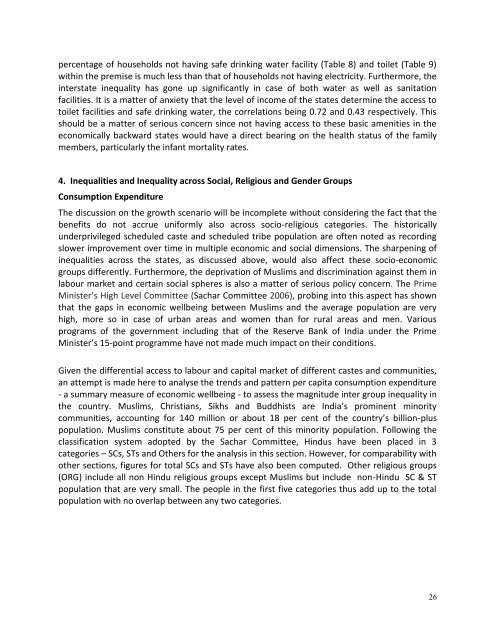Spatial and Social Inequalities in Human Development: India in the ...
Spatial and Social Inequalities in Human Development: India in the ...
Spatial and Social Inequalities in Human Development: India in the ...
You also want an ePaper? Increase the reach of your titles
YUMPU automatically turns print PDFs into web optimized ePapers that Google loves.
percentage of households not hav<strong>in</strong>g safe dr<strong>in</strong>k<strong>in</strong>g water facility (Table 8) <strong>and</strong> toilet (Table 9)with<strong>in</strong> <strong>the</strong> premise is much less than that of households not hav<strong>in</strong>g electricity. Fur<strong>the</strong>rmore, <strong>the</strong><strong>in</strong>terstate <strong>in</strong>equality has gone up significantly <strong>in</strong> case of both water as well as sanitationfacilities. It is a matter of anxiety that <strong>the</strong> level of <strong>in</strong>come of <strong>the</strong> states determ<strong>in</strong>e <strong>the</strong> access totoilet facilities <strong>and</strong> safe dr<strong>in</strong>k<strong>in</strong>g water, <strong>the</strong> correlations be<strong>in</strong>g 0.72 <strong>and</strong> 0.43 respectively. Thisshould be a matter of serious concern s<strong>in</strong>ce not hav<strong>in</strong>g access to <strong>the</strong>se basic amenities <strong>in</strong> <strong>the</strong>economically backward states would have a direct bear<strong>in</strong>g on <strong>the</strong> health status of <strong>the</strong> familymembers, particularly <strong>the</strong> <strong>in</strong>fant mortality rates.4. <strong>Inequalities</strong> <strong>and</strong> Inequality across <strong>Social</strong>, Religious <strong>and</strong> Gender GroupsConsumption ExpenditureThe discussion on <strong>the</strong> growth scenario will be <strong>in</strong>complete without consider<strong>in</strong>g <strong>the</strong> fact that <strong>the</strong>benefits do not accrue uniformly also across socio-religious categories. The historicallyunderprivileged scheduled caste <strong>and</strong> scheduled tribe population are often noted as record<strong>in</strong>gslower improvement over time <strong>in</strong> multiple economic <strong>and</strong> social dimensions. The sharpen<strong>in</strong>g of<strong>in</strong>equalities across <strong>the</strong> states, as discussed above, would also affect <strong>the</strong>se socio-economicgroups differently. Fur<strong>the</strong>rmore, <strong>the</strong> deprivation of Muslims <strong>and</strong> discrim<strong>in</strong>ation aga<strong>in</strong>st <strong>the</strong>m <strong>in</strong>labour market <strong>and</strong> certa<strong>in</strong> social spheres is also a matter of serious policy concern. The PrimeM<strong>in</strong>ister’s High Level Committee (Sachar Committee 2006), prob<strong>in</strong>g <strong>in</strong>to this aspect has shownthat <strong>the</strong> gaps <strong>in</strong> economic wellbe<strong>in</strong>g between Muslims <strong>and</strong> <strong>the</strong> average population are veryhigh, more so <strong>in</strong> case of urban areas <strong>and</strong> women than for rural areas <strong>and</strong> men. Variousprograms of <strong>the</strong> government <strong>in</strong>clud<strong>in</strong>g that of <strong>the</strong> Reserve Bank of <strong>India</strong> under <strong>the</strong> PrimeM<strong>in</strong>ister’s 15-po<strong>in</strong>t programme have not made much impact on <strong>the</strong>ir conditions.Given <strong>the</strong> differential access to labour <strong>and</strong> capital market of different castes <strong>and</strong> communities,an attempt is made here to analyse <strong>the</strong> trends <strong>and</strong> pattern per capita consumption expenditure- a summary measure of economic wellbe<strong>in</strong>g - to assess <strong>the</strong> magnitude <strong>in</strong>ter group <strong>in</strong>equality <strong>in</strong><strong>the</strong> country. Muslims, Christians, Sikhs <strong>and</strong> Buddhists are <strong>India</strong>’s prom<strong>in</strong>ent m<strong>in</strong>oritycommunities, account<strong>in</strong>g for 140 million or about 18 per cent of <strong>the</strong> country’s billion-pluspopulation. Muslims constitute about 75 per cent of this m<strong>in</strong>ority population. Follow<strong>in</strong>g <strong>the</strong>classification system adopted by <strong>the</strong> Sachar Committee, H<strong>in</strong>dus have been placed <strong>in</strong> 3categories – SCs, STs <strong>and</strong> O<strong>the</strong>rs for <strong>the</strong> analysis <strong>in</strong> this section. However, for comparability witho<strong>the</strong>r sections, figures for total SCs <strong>and</strong> STs have also been computed. O<strong>the</strong>r religious groups(ORG) <strong>in</strong>clude all non H<strong>in</strong>du religious groups except Muslims but <strong>in</strong>clude non-H<strong>in</strong>du SC & STpopulation that are very small. The people <strong>in</strong> <strong>the</strong> first five categories thus add up to <strong>the</strong> totalpopulation with no overlap between any two categories.26


